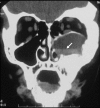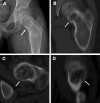McCune-Albright syndrome
- PMID: 18489744
- PMCID: PMC2459161
- DOI: 10.1186/1750-1172-3-12
McCune-Albright syndrome
Abstract
McCune-Albright syndrome (MAS) is classically defined by the clinical triad of fibrous dysplasia of bone (FD), café-au-lait skin spots, and precocious puberty (PP). It is a rare disease with estimated prevalence between 1/100,000 and 1/1,000,000. FD can involve a single or multiple skeletal sites and presents with a limp and/or pain, and, occasionally, a pathologic fracture. Scoliosis is common and may be progressive. In addition to PP (vaginal bleeding or spotting and development of breast tissue in girls, testicular and penile enlargement and precocious sexual behavior in boys), other hyperfunctioning endocrinopathies may be involved including hyperthyroidism, growth hormone excess, Cushing syndrome, and renal phosphate wasting. Café-au-lait spots usually appear in the neonatal period, but it is most often PP or FD that brings the child to medical attention. Renal involvement is seen in approximately 50% of the patients with MAS. The disease results from somatic mutations of the GNAS gene, specifically mutations in the cAMP regulating protein, Gs alpha. The extent of the disease is determined by the proliferation, migration and survival of the cell in which the mutation spontaneously occurs during embryonic development. Diagnosis of MAS is usually established on clinical grounds. Plain radiographs are often sufficient to make the diagnosis of FD and biopsy of FD lesions can confirm the diagnosis. The evaluation of patients with MAS should be guided by knowledge of the spectrum of tissues that may be involved, with specific testing for each. Genetic testing is possible, but is not routinely available. Genetic counseling, however, should be offered. Differential diagnoses include neurofibromatosis, osteofibrous dysplasia, non-ossifying fibromas, idiopathic central precocious puberty, and ovarian neoplasm. Treatment is dictated by the tissues affected, and the extent to which they are affected. Generally, some form of surgical intervention is recommended. Bisphosphonates are frequently used in the treatment of FD. Strengthening exercises are recommended to help maintaining the musculature around the FD bone and minimize the risk for fracture. Treatment of all endocrinopathies is required. Malignancies associated with MAS are distinctly rare occurrences. Malignant transformation of FD lesions occurs in probably less than 1% of the cases of MAS.
Figures









References
-
- McCune DJ. Osteitis fibrosa cystica: the case of a nine-year-old girl who also exhibits precocious puberty, multiple pigmentation of the skin and hyperthyroidism. Am J Dis Child. 1936;52:743–744.
-
- Albright F, Butler AM, Hampton AO, Smith P. Syndrome characterized by osteitis fibrosa disseminata, areas, of pigmentation, and endocrine dysfunction, with precocious puberty in females: report of 5 cases. N Engl J Med. 1937;216:727–746.
-
- Mastorakos G, Mitsiades NS, Doufas AG, Koutras DA. Hyperthyroidism in McCune-Albright syndrome with a review of thyroid abnormalities sixty years after the first report. Thyroid. 1997;7:433–439. - PubMed
-
- Sherman SI, Ladenson PW. Octreotide therapy of growth hormone excess in the McCune-Albright syndrome. Journal of endocrinological investigation. 1992;15:185–190. - PubMed
-
- Akintoye SO, Chebli C, Booher S, Feuillan P, Kushner H, Leroith D, Cherman N, Bianco P, Wientroub S, Robey PG, Collins MT. Characterization of gsp-mediated growth hormone excess in the context of McCune-Albright syndrome. J Clin Endocrinol Metab. 2002;87:5104–5112. doi: 10.1210/jc.2001-012022. - DOI - PubMed
MeSH terms
LinkOut - more resources
Full Text Sources
Medical
Research Materials
Miscellaneous

